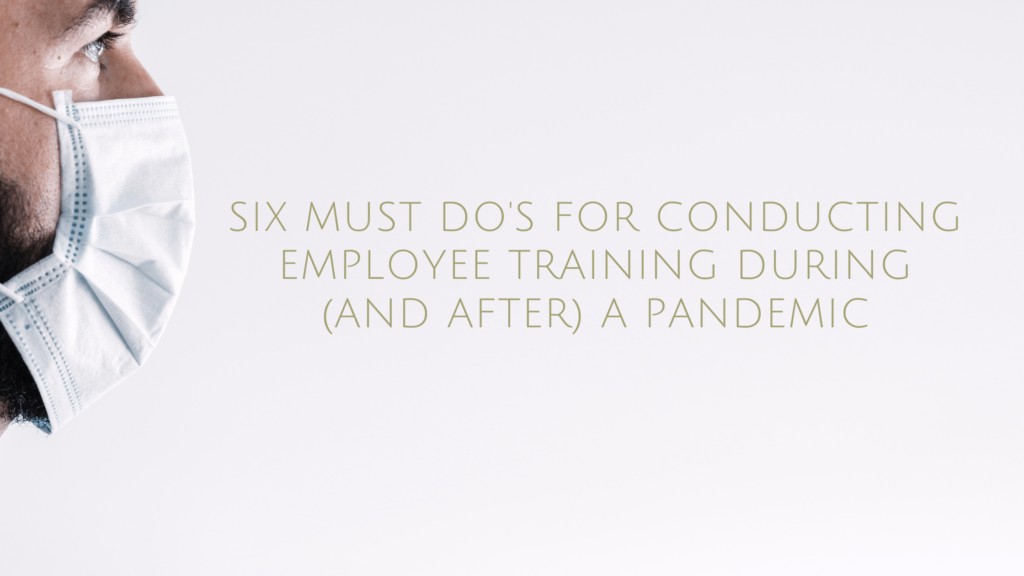Even before COVID-19 hit my team was doing a lot of virtual training in the form of webinars, e-learning and mobile learning. After COVID hit that increased as we had to quickly pivot to transform in person learning programs to online. While there does appear to be some light at the end of the tunnel with more and more people being vaccinated, it\’s still a good idea to be prepared to continue with virtual learning for the foreseeable future.
Here are some things you need to do as we all continue to flex.
- Be flexible
- Stay patient
- Maintain positivity
- Keep innovating
- Continue to blend
- Create a transition plan
I fully expect to continue holding classes that were formerly in person online for a while. That being the case, here is my planned approach.
Be flexible
This is something we have all had to learn during this pandemic. It seems like every time we think things will get \”back to normal\” something happens that sets us back. That\’s why it is important to maintain flexibility as you plan your training. Even if it looks like your in person, instructor-led class is going to move forward, you should have a plan for moving it back to virtual again if needed.
That\’s assuming it\’s an existing class you have already been holding virtually. In the case of a newly developed class, I\’d look at ways to bake in some virtual aspects as well as thinking about how the in person part could be done virtually in a pinch.
Stay Patient
Along with being flexible is staying patient throughout. It\’s going to be very tempting to want to rush back to what we did before. Technology has come a long way and we are able to do a lot of really cool things online. Still, it just isn\’t the same as being in a room together and interacting so it\’s understandable that most of us would like to be able to do that again soon.
I think there are a couple of things to keep in mind, though. Of course, there is the obvious pandemic thing. Just as what has been happening all along, there could be some new outbreak or someone teaching or attending your class could get infected. This could certainly cause a delay to getting back to in person training.
Another thought that I\’ve been kicking around is the appeal of virtual training to a company\’s bottom line. I hate to say it but I can totally see some companies keeping previously converted classroom training virtual for good. No travel, food or conference room costs could be very attractive.
My hope is that leadership will look beyond cost and see the value in holding training in person. But, in the meantime, we will all need to be patient (and flexible).
Maintain Positivity
This kind of goes along with being flexible and patient. What I really wanted to point out here is not just staying positive for yourself but to maintain it for your learners.
Something you might hear in a virtual training class is \”well, NORMALLY we would be onsite doing xyz…\” I am not saying we should never speak of what has happened traditionally in a particular class. I do think we need to have an awareness of how and when we mention it. The last thing you want to do is make your learners feel like they are somehow getting a second hand learning experience. \”Too bad for you, you\’re stuck in this webinar. Two years ago, we were in Hawaii and the conference room was right on the beach!\”
I don\’t actually know of any company who holds training on a Hawaiian beach but you get the idea. We owe it to our learners to provide the best experience possible regardless of location or modality. So, make sure to keep any mention of the \”way it was\” to a minimum and focus on the awesomeness of what you are doing now.
Keep Innovating
As I mentioned, many companies have gotten a taste for virtual training who maybe hadn\’t really done as much before. Even when the pandemic is over, the demand for virtual training solutions will continue to increase. If you want to be a part of those solutions, you will want to continue to keep yourself up to date on the various technologies and techniques.
Having said that, I do think people (myself included) can get a little too wrapped up in the technology. It\’s important not to lose sight of who we are doing all of this for: our learners. Even as you learn and discover new ways to use Zoom or VR or some other cool technology, don\’t forget to stay focused on them.
Continue to Blend
When we do go back to teaching our in person training classes (and we will…right?) we might think we don\’t need to keep all of the converted virtual materials or activities. I would definitely recommend to not only keep them but to find ways to continue to use them along with your in person class.
An example might be a lecture that a SME (subject matter expert) would normally come in and do in person. If that got converted to e-learning or a webinar, I would consider keeping it as such. That way you free up precious time in the in person session. You can still involve the SME with the in person class but instead of the usual lecture, you can set up a Q&A or have them assist with an activity that helps the learners understand and practice their topic.
Create a Transition Plan
It may still be some time before some of us go back to regularly scheduled in person employee training classes. I know for one of mine, we are going to stay virtual for the rest of this year. Still, it isn\’t too early to start thinking about how we will transition back.
I am already thinking about activities to keep from our virtual sessions. I am also rethinking some of the sessions we used to do. For example, any lecture heavy sections we used to have I would like to focus on how to make that time more valuable. What can we have the learners doing or practicing in lieu of sitting through a 30 – 60 minute lecture?
I am also thinking about how to get everyone on the same page. For example, SME presenters who have been doing the same lecture for years. I want to make sure to keep them involved with the transition so when we do get back to being in person, I have their buy in for any changes we are planning to implement.
Leadership is another group to keep in mind for transitioning back. Throughout the experience of training virtually, my team has made sure to point out our successes to leadership. Of course we want to show that we have been up to the challenge. That\’s great but, if we are to transition back to in person, we are going to have to really think about the messaging to leadership.
I mentioned that leaders could very well want to just stay with all virtual for employee training solutions. It will take some finessing to point out the things virtual training doesn\’t do well. You don\’t want to discount all of the success you\’ve had but you do want them to understand how in person training is still a very valuable (and needed) option.
Conclusion
The pandemic has been a challenge for everyone on a million different levels. As a learning and development professional, I am trying to use it as an opportunity to get better and more creative in the way I design and develop training for my learners. I believe we will get to a place where we can conduct employee training in person again. When we do, instead of rushing back to \”the way it was\” let\’s challenge ourselves to embrace what we\’ve learned and make it even better!

